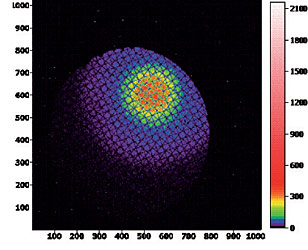A terawatt laser complex generating laser pulses with duration of about 70 fs, pulse energy up to
100 mJ and repetition rate of 10 Hz has been created at IAP RAS. A wide series of experiments on the interaction of high-intensity femtosecond laser radiation with solids, gases and plasmas have been accomplished on this laser complex under the supervision of
A. N. Stepanov. For instance, nonlinear processes occurring during propagation of intense laser radiation in the atmosphere have been extensively studied.
The effect of nonlinear absorption has been discovered, which is associated with the excitation of a rotational wave packet of molecules constituting the air. The influence of atmospheric turbulence on multiple filamentation of laser beams has been studied. Using precision interferometry, the value and spatial distribution of the concentration of the plasma produced during laser beam filamentation have been retrieved. In order to apply femtosecond laser radiation to remote sensing of the atmosphere, the characteristics of radiation backscattered by water aerosol particles under the conditions when plasma formation inside the aerosol particle becomes important are studied.
Also, investigations of electron acceleration and X-ray generation by intense femtosecond laser pulses are being performed on the IAP terawatt laser complex.
An injector producing electrons to be further accelerated in the plasma wave has been studied.
A beam of energetic electrons was generated by exposing microstructured metal foils to laser radiation with an intensity of about 10
<ûãç>17
W/cm2.
In experiments on the excitation of plasma waves in gas-filled dielectric capillary tubes a method for measuring the plasma wave amplitude using modifications of the laser pulse spectrum has been
tested.
 |
Spatial distribution of the phase shift (left) corresponding to the beginning of the filament (laser pulse energy
5.4 mJ), phase shift averaged over the filament (center) and transverse profile of electron density (right)
|
To create a soft X-ray source, intense femtosecond laser pulses were focused onto the entrance of a dielectric capillary tube filled with noble gas. As a result, collimated X-ray beams were produced, which can be used for diagnostics of dense solid-state plasmas and biological objects.
|

|
Distribution of plasma concentration in a droplet (calculated). Laser radiation with intensity 1013 W/cm2 comes from below
|
Collimated X-ray beam generated by exposing a xenon-filled dielectric capillary tube to a femtosecond laser pulse with energy 55 mJ
|





